 IST,
IST,
V. Financial Markets
International financial markets in Q1 of 2005-06 were characterised by an environment of uncertainty emanating from high and volatile international crude oil prices, the upturn in the global interest rate cycle and political uncertainty in the Euro area. Short-term interest rates moved up further in a number of economies, notably the US. In other countries/areas such as the UK and the Euro area, short-term interest rates reversed their rising trend in the face of a weakening of economic activity (Table 23). Long-term interest rates also moved down, while equity prices gained, indicating some easing of financial conditions during the quarter.
|
Table 23: Short-term Interest Rates |
|||
|
(Percent) |
|||
|
March 2004 |
March 2005 |
June 2005 |
|
|
1 |
2 |
3 |
4 |
|
Advanced Economies |
|||
|
US |
1.04 |
2.90 |
3.33 |
|
UK |
4.31 |
4.95 |
4.75 |
|
Euro Area |
1.96 |
2.15 |
2.10 |
|
Japan |
0.03 |
0.02 |
0.02 |
|
Sweden |
2.12 |
1.97 |
1.48 |
|
Emerging Market Economies |
|||
|
China |
– |
2.25 |
2.30 |
|
Hong Kong |
0.17 |
2.79 |
3.36 |
|
South Korea |
3.90 |
3.54 |
3.52 |
|
Argentina |
2.88 |
4.56 |
6.94 |
|
Brazil |
16.02 |
19.25 |
19.74 |
|
Malaysia |
3.00 |
2.82 |
2.87 |
|
Philippines |
9.19 |
7.25 |
5.88 |
|
Singapore |
0.69 |
2.06 |
2.06 |
|
Thailand |
1.31 |
2.64 |
2.75 |
|
– : Not available. |
|||
Long-term government bond yields declined during April-June 2005 on expectations that monetary authorities could slow down policy tightening due to fragility in the economic recovery. Demand for fixed income products from baby boomers approaching retirement provided some support to long-term gilts (Chart 36). In the US, the 10-year Treasury yield at 3.8 per cent was at a 14-month low on June 3, 2005. Japanese 10-year bond yields and Euro area bond yields also dropped to record lows in May and June 2005. Similarly, yield curves in Australia, New Zealand and the UK have flattened or inverted.
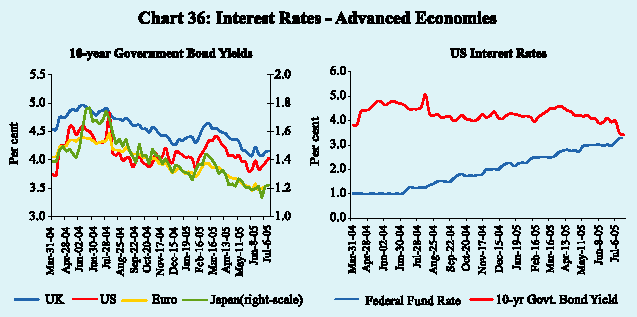
Equity markets witnessed rallies during June 2005, reflecting buying opportunities in the wake of a dip during April-May 2005 as a result of higher oil prices. The Indian stock markets, in particular, outperformed the stock indices of major economies (Chart 37).
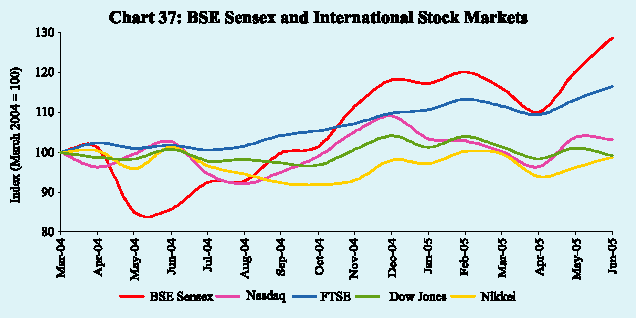
The US dollar appreciated against major currencies during Q1 of 2005-06, reflecting growing interest differentials in favour of the US and uncertainty in the Euro area (Chart 38).
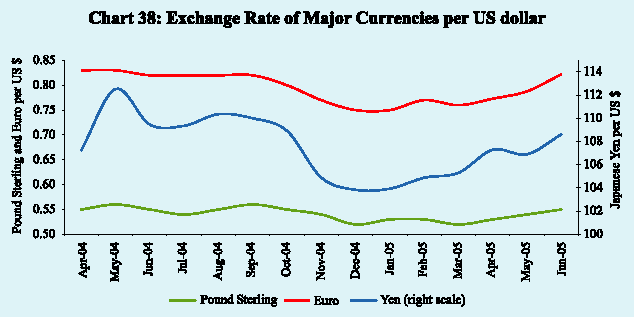
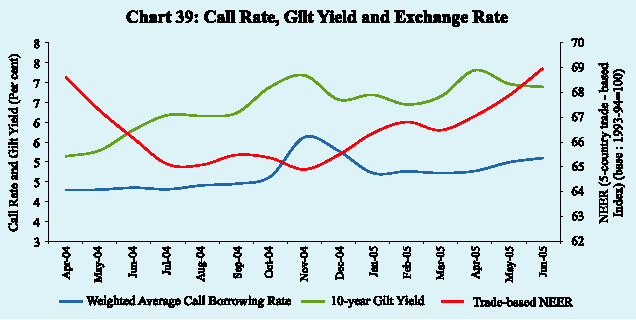
|
Table 24: Domestic Financial Markets at a Glance |
|||||||||||||||
|
Month |
Call Money |
Govt. Securities |
Foreign Exchange |
Liquidity Management |
Equity |
||||||||||
|
Average Daily Turnover(Rs. crore) |
Average Call Rates(Percent) |
10- Year Yield (Percent) |
Turnover in Govt. Securities (Rs. crore)+ |
Average Daily Inter- bank Turnover (US $ million) |
Average Exchange Rate(Rs. per US $) Purchases |
RBI’s net Foregin Currency Sales(-)/Purchases (+)(US $ million) |
Forward Premia 3-month (Per cent) |
MSS Out- standing (Rs. crore) |
Average Daily Reverse Repo (LAF) Outstanding (Rs. crore) |
Average Daily BSE Turnover (Rs. crore) |
Average Daily NSE Turnover (Rs. crore) |
Average BSE Sensex |
Average S&P CNX Nifty |
||
|
1 |
2 |
3 |
4 |
5 |
6 |
7 |
8 |
9 |
10 |
11 |
12 |
13 |
14 |
15 |
|
|
2004-05 |
|||||||||||||||
|
April |
12,916 |
4.29 |
5.14 |
3,00,864 |
10,118 |
43.93 |
7,427 |
(-) 0.36 |
22,851 |
75,006 |
2,243 |
5,048 |
5,809 |
1,848 |
|
|
May |
10,987 |
4.30 |
5.29 |
1,92,264 |
8,521 |
45.25 |
-220 |
(-)1.33 |
30,701 |
74,502 |
2,188 |
4,710 |
5,205 |
1,640 |
|
|
June |
10,973 |
4.35 |
5.81 |
1,75,802 |
7,741 |
45.51 |
-413 |
0.93 |
37,812 |
61,981 |
1,681 |
3,859 |
4,824 |
1,506 |
|
|
July |
8,632 |
4.31 |
6.18 |
1,30,400 |
7,684 |
46.04 |
-1,180 |
2.25 |
46,206 |
59,594 |
1,793 |
4,265 |
4,973 |
1,568 |
|
|
August |
11,562 |
4.41 |
6.16 |
1,29,373 |
5,753 |
46.34 |
-876 |
2.85 |
51,635 |
42,692 |
1,736 |
3,948 |
5,144 |
1,615 |
|
|
September |
17,088 |
4.45 |
6.23 |
1,75,635 |
7,266 |
46.10 |
19 |
2.20 |
52,255 |
31,589 |
1,800 |
4,023 |
5,423 |
1,692 |
|
|
October |
16,667 |
4.63 |
6.89 |
1,12,709 |
7,039 |
45.78 |
-99 |
2.87 |
55,087 |
10,805 |
1,730 |
3,785 |
5,702 |
1,795 |
|
|
November |
13,820 |
5.62 |
7.18 |
78,225 |
9,808 |
45.13 |
3,792 |
2.16 |
51,872 |
-5,066 |
1,786 |
4,102 |
5,961 |
1,874 |
|
|
December |
19,527 |
5.28 |
6.57 |
1,33,447 |
9,309 |
43.98 |
1,393 |
2.03 |
53,481 |
7,570 |
2,183 |
5,026 |
6,394 |
2,022 |
|
|
January |
16,534 |
4.72 |
6.69 |
1,10,535 |
8,703 |
43.75 |
0 |
2.50 |
54,499 |
18,721 |
2,310 |
5,249 |
6,307 |
1,978 |
|
|
February |
16,041 |
4.76 |
6.45 |
1,29,917 |
11,404 |
43.68 |
4,974 |
1.99 |
60,835 |
19,895 |
2,484 |
4,999 |
6,595 |
2,067 |
|
|
March |
15,293 |
4.72 |
6.65 |
87,892 |
10,645 |
43.69 |
6,030 |
1.82 |
64,211 |
29,809 |
2,706 |
5,139 |
6,679 |
2,096 |
|
|
2005-06 |
|||||||||||||||
|
April |
17,213 |
4.77 |
7.31 |
90,040 |
9,440 |
43.74 |
0 |
1.96 |
67,087 |
30,675 |
1,890 |
4,136 |
6,379 |
1,987 |
|
|
May |
15,269 |
4.99 |
6.97 |
1,17,969 |
9,759 |
43.49 |
0 |
1.57 |
69,016 |
13,916 |
1,971 |
3,946 |
6,483 |
2,002 |
|
|
June |
20,135 |
5.10 |
6.89 |
2,04,197 |
10,837 |
43.58 |
– |
1.40 |
71,681 |
22,754 |
2,543 |
4,843 |
6,926 |
2,134 |
|
|
+:Outright turnover in Central Government dated securities. BSE:The Stock Exchange, Mumbai. – : Not available. |
|||||||||||||||
Money Market
Money markets began Q1 of 2005-06 under conditions of comfortable liquidity stemming from the overhang in the system. Despite capital outflows in April, the Reserve Bank had to supplement reverse repo operations with sale of Government paper under the Market Stabilisation Scheme (MSS) to absorb liquidity and balance market conditions. Average daily call money borrowing rates ruled at sub-reverse repo rate levels on many occasions. With the increase in the fixed reverse repo rate by 25 basis points on April 29, 2005, call rates also edged up by a similar magnitude. Towards the end of June 2005, call rates rose above the reverse repo rate under demand pressures emanating from advance tax payments, scheduled Treasury Bills auctions and a higher oil import bill (Chart 40). The Reserve Bank injected Rs.210 crore and Rs.575 crore under the LAF repo on June 28, 2005 and June 30, 2005, respectively, to assuage the demand pressure. Call money rates eased by mid-July, 2005 and stood at 5.04 per cent on July 20, 2005.
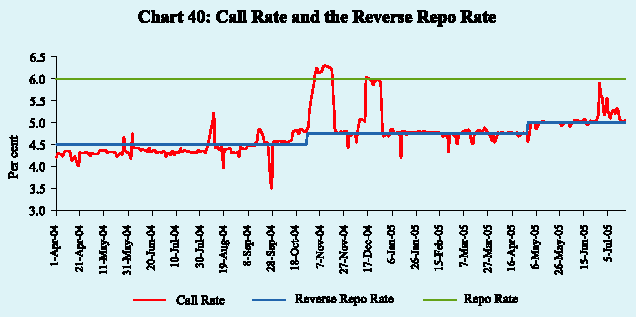
Collateralised Borrowing and Lending Obligations (CBLO) transactions continued to expand as it provides funds at lower cost (Chart 41). The supply of funds in the CBLO segment has also been augmented by the participation of mutual funds and financial institutions. Members operating in the CBLO segment of the Clearing Corporation of India Limited (CCIL) increased from 110 members in March 2005 to 115 by June 2005.
|
Table 25: Turnover in Money Markets |
|||
|
(Rs. crore) |
|||
|
Month |
Call /Notice Money |
CBLO |
Market Repo |
|
1 |
2 |
3 |
4 |
|
2004-05 |
|||
|
April |
12,916 |
2,496 |
15,195 |
|
May |
10,987 |
3,872 |
15,932 |
|
June |
10,973 |
4,015 |
17,517 |
|
July |
8,632 |
4,508 |
19,226 |
|
August |
11,562 |
4,962 |
13,561 |
|
September |
17,088 |
6,149 |
18,178 |
|
October |
16,667 |
8,466 |
15,719 |
|
November |
13,820 |
9,651 |
18,560 |
|
December |
19,527 |
9,962 |
21,922 |
|
January |
16,534 |
7,701 |
17,556 |
|
February |
16,041 |
8,952 |
17,562 |
|
March |
15,293 |
9,625 |
14,688 |
|
2005-06 |
|||
|
April |
17,213 |
10,369 |
12,174 |
|
May |
15,269 |
12,233 |
13,688 |
|
June |
20,147 |
12,075 |
17,163 |
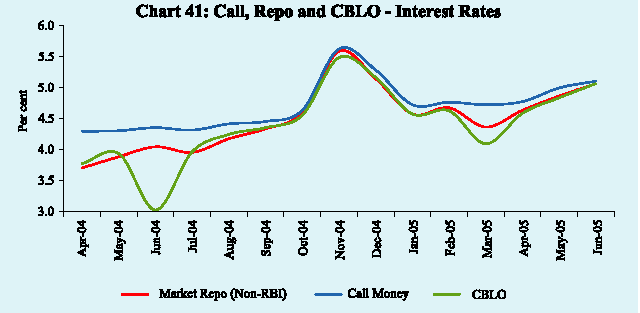
Comfortable liquidity conditions at the beginning of Q1of 2005-06 evinced a favourable market response to Treasury Bill (TB) auctions which was reflected in high bid-cover ratios (competitive bid amount received to notified amount) for 91-day TBs (Table 26). Bid-cover ratios declined in June 2005 as there was some liquidity tightening. 182-day TBs, which were reintroduced in April 2005, also attracted the interest of market participants.
|
Table 26: Treasury Bills in the Primary Market |
||||||
|
Month |
Average Implicit Yield at Minimum |
Bid-Cover Ratio |
||||
|
Cut-off Price (Per cent) |
||||||
|
91-day |
182-day |
364-day |
91-day |
182-day |
364-day |
|
|
1 |
2 |
3 |
4 |
5 |
6 |
7 |
|
2004-05 |
||||||
|
April |
4.38 |
4.44 |
2.15 |
2.47 |
||
|
May |
4.39 |
4.33 |
2.93 |
2.46 |
||
|
June |
4.44 |
4.55 |
2.61 |
1.28 |
||
|
July |
4.46 |
4.60 |
2.39 |
2.06 |
||
|
August |
4.76 |
5.00 |
1.81 |
3.36 |
||
|
September |
4.72 |
5.14 |
2.51 |
2.83 |
||
|
October |
5.15 |
5.46 |
1.82 |
2.75 |
||
|
November |
5.47 |
5.71 |
2.80 |
2.64 |
||
|
December |
5.30 |
5.69 |
2.69 |
2.81 |
||
|
January |
5.31 |
5.69 |
2.19 |
2.06 |
||
|
February |
5.25 |
5.65 |
2.99 |
2.81 |
||
|
March |
5.24 |
5.63 |
2.31 |
2.74 |
||
|
2005-06 |
||||||
|
April |
5.17 |
5.36 |
5.62 |
4.03 |
4.48 |
2.54 |
|
May |
5.19 |
5.35 |
5.58 |
3.30 |
3.37 |
2.29 |
|
June |
5.29 |
5.37 |
5.61 |
1.54 |
2.42 |
1.81 |
Primary yields edged down marginally during the quarter, enabled by softening of headline inflation. The yield spread between the 91-day and 364-day TBs at about 30 basis points in June 2005 was generally comparable with the second half of 2004-05 (Chart 42).
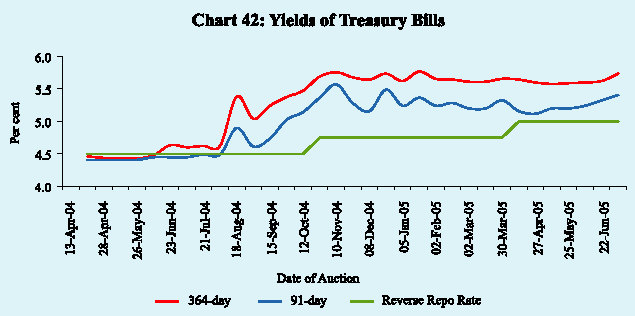
The commercial paper (CP) market remained buoyant in line with seasonal trends.Outstanding CPs increased from Rs.14,235 crore at end-March 2005 to Rs.17,782 crore by June 30, 2005. Leasing and finance companies continue to be the largest issuers of CPs, partly reflecting the policy of phasing out the access of these companies to public deposits. These companies had a share of 59.6 per cent in the total CP outstanding at end-June 2005. Despite a pick-up in issuances, the weighted average discount rate (WADR) on CPs softened by five basis points during the quarter to 5.79 per cent on June 30, 2005 over its level on March 31, 2005, reflecting comfortable liquidity conditions (Chart 43).
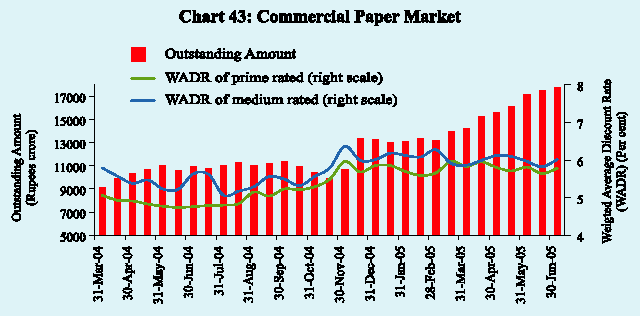
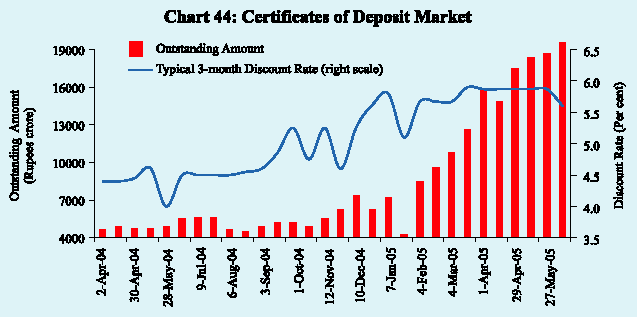
|
Table 27: Forward Rate Agreements and Interest Rate Swaps |
||
|
Month |
No. of Contracts |
Notional Amount |
|
(Rs. crore) |
||
|
1 |
2 |
3 |
|
2004-05 |
||
|
April |
20,413 |
5,76,808 |
|
May |
23,331 |
6,11,595 |
|
June |
22,670 |
6,04,669 |
|
July |
23,013 |
5,90,118 |
|
August |
23,880 |
6,40,173 |
|
September |
31,252 |
8,53,195 |
|
October |
34,371 |
9,25,175 |
|
November |
32,996 |
9,50,151 |
|
December |
37,507 |
9,75,135 |
|
January |
39,083 |
10,14,442 |
|
February |
35,724 |
9,46,293 |
|
March |
37,864 |
10,62,242 |
|
2005-06 |
||
|
April |
38,386 |
10,76,513 |
|
May |
39,923 |
10,72,684 |
|
June |
41,174 |
10,93,367 |
Foreign Exchange Market
In the foreign exchange market, outflows by FIIs and a higher merchandise trade deficit could not prevent the rupee from firming up against the US dollar from Rs. 43.7550 at end-March 2005 to Rs. 43.2950 per US dollar on May 12, 2005. In subsequent weeks, the Indian rupee depreciated to Rs. 43.7600 per US dollar on June 2, 2005 due to strengthening of the US dollar in the international markets. On the whole, the Indian rupee appreciated by 0.6 per cent to Rs.43.5150 per US dollar on June 30, 2005 over its level on March 31, 2005. Reflecting cross-currency movements, the rupee also appreciated against the other major international currencies: the Euro (7.5 per cent), the Pound sterling (4.3 per cent) and the Japanese yen (3.3 per cent) (Chart 45). This resulted in an appreciation of the nominal effective exchange rate (NEER) by 3.8 per cent during the quarter. The rupee remained broadly stable against the US dollar thereafter and stood at Rs. 43.5400 per US dollar as on July 20, 2005.
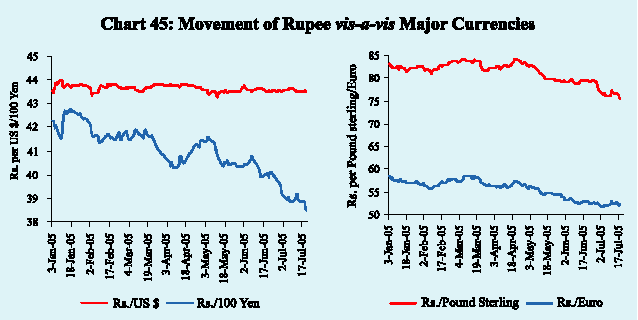
Spot market conditions kept forward premia low during Q1 of 2005-06. Forward premia also declined in view of the announcement relating to phasing out the Mumbai Inter-bank Forward Offered Rate (MIFOR) from pricing interest rate derivative deals for non-banks (Chart 46). Forward premia recovered marginally in July 2005.
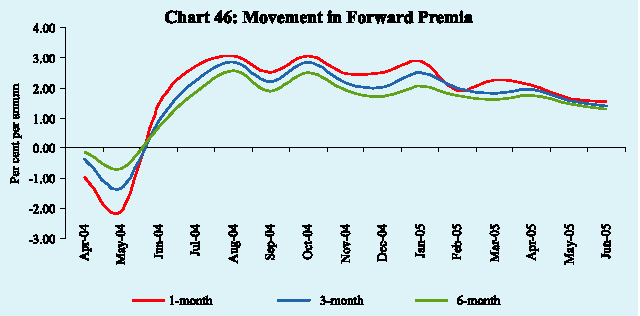
Volumes in the foreign exchange market were subdued during the quarter. The turnover in the foreign exchange market (both merchant and inter-bank) dropped sharply to US $ 223.6 billion in April 2005 from US $ 305.7 billion in the previous month. Transaction volumes, however, recovered to US $ 284.4 billion in May 2005 and further to US $ 330.9 billion in June 2005 (Chart 47).
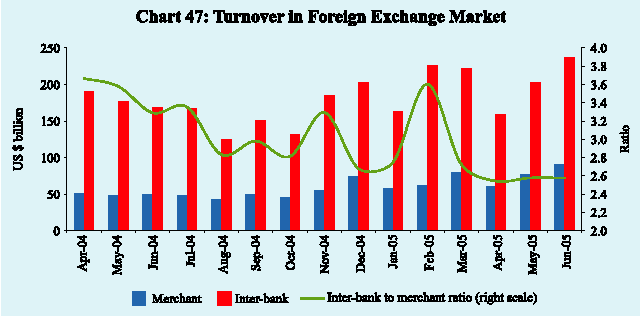
Credit Market
The demand for credit from the commercial sector strengthened further of 2005-06 (Chart 48). As on July 8, 2005 the year-on-year non-food during Q1 credit grew by 30.6 per cent (net of conversion) on top of 23.0 per cent growth in the corresponding period of the previous year. Food credit extended by the banking system in the first quarter of 2005-06 was lower as compared with the corresponding period of the previous year on account of lower procurement.
Incremental credit to medium and large industries more than trebled to Rs.42,976 crore during 2004-05 (Table 28). Credit to the priority sector
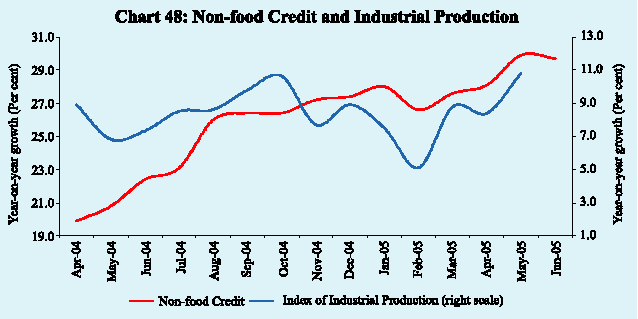
continued to grow at a strong pace. In particular, credit to agriculture accelerated by 35.2 per cent during 2004-05 from 23.2 per cent during the previous year. There was also a sustained expansion in credit to small-scale industries, housing and personal loans.
|
Table 28: Deployment of Non-food Bank Credit –Variations |
|||||
|
(Rupees crore) |
|||||
|
Sector/Industry |
2003-04 |
2004-05 |
|||
|
Absolute |
Per cent |
Absolute |
Per cent |
||
|
1 |
2 |
3 |
4 |
5 |
|
|
1. |
Priority sector# |
52,225 |
24.7 |
81,793 |
31.0 |
|
Agriculture |
17,023 |
23.2 |
31,829 |
35.2 |
|
|
Small Scale Industries |
5,461 |
9.0 |
10,259 |
15.6 |
|
|
Others |
29,741 |
38.3 |
39,705 |
37.0 |
|
|
2. |
Industry (Medium & Large) |
12,042 |
5.1 |
42,976 |
17.4 |
|
Petroleum |
-2,477 |
-16.8 |
2,352 |
19.2 |
|
|
Infrastructure |
10,927 |
41.6 |
19,485 |
52.3 |
|
|
Other Metal & |
-388 |
-4.5 |
1,428 |
17.5 |
|
|
Metal Products |
|||||
|
Construction |
1,087 |
22.2 |
1,985 |
33.2 |
|
|
Drugs & Pharmaceuticals |
775 |
9.8 |
2,007 |
23.2 |
|
|
Gems & Jewellery |
1,645 |
21.8 |
2,945 |
32.1 |
|
|
Rubber & Rubber Products |
-69 |
-2.6 |
568 |
21.9 |
|
|
Cotton Textiles |
1,404 |
8.9 |
2,845 |
16.6 |
|
|
Automobiles |
-327 |
-5.8 |
1,061 |
20.0 |
|
|
Cement |
-742 |
-11.5 |
423 |
7.4 |
|
|
3. |
Housing |
15,394 |
42.1 |
23,192 |
44.6 |
|
4. |
Non-Banking Financial |
2,675 |
18.9 |
1,808 |
10.8 |
|
Companies |
|||||
|
5. |
Wholesale Trade |
2,289 |
10.1 |
8,947 |
36.0 |
|
6. |
Export Credit |
8,485 |
17.2 |
8,227 |
14.3 |
|
7. |
Non-food Gross Bank Credit |
1,08,367 |
17.5 |
2,03,044 |
27.9 |
|
# : Excluding investment in eligible securities. |
|||||
The sharp increase in industrial credit during 2004-05 was dominated by seven sectors, viz., infrastructure, petroleum, construction, gems and jewellery, cotton textiles, drugs and pharmaceuticals and iron and steel which accounted for as much as 65 per cent of the incremental offtake during the year. The higher demand for credit by infrastructure industries and construction was in consonance with their strong performance. Growth in credit to the roads and ports sector, in particular, accelerated to 83.2 per cent during 2004-05 from 67.3 per cent during the previous year. Petroleum credit increased by 19.2 per cent in contrast to the decline of 16.8 per cent in the previous year. The turnaround was due to an incomplete pass-through of the increase in international crude oil prices to domestic petroleum products prices. The higher credit to the gems and jewellery sector was driven by export demand. Other industries which recorded higher credit offtake were other metal and metal products, rubber and rubber products and other textiles (Chart 49).
During April 2005, credit to medium and large industries increased by 5.2 per cent as compared with 2.4 per cent in the corresponding period of pervious year, indicating the buoyancy in industrial growth. Housing and real estate loans continued to grow at a high rate.
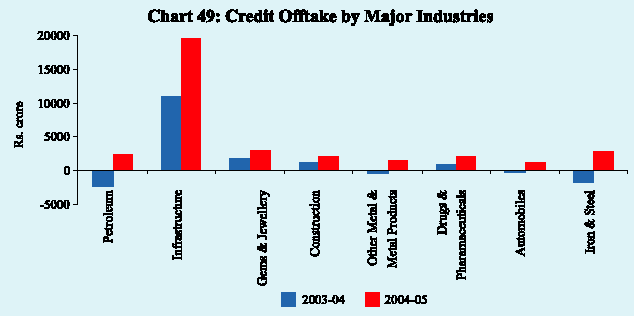
Public sector banks (PSBs) realigned their deposit rates in the tenor of one year and above from a range of 4.75-7.00 per cent in March 2005 to 5.25-6.50 per cent by June 2005. Deposit rates of private banks for more than three years maturity edged up by 25 basis points (Table 29). Benchmark prime lending rates
|
Table 29: Movements in Deposit and Lending Rates |
||||||||
|
(Percent) |
||||||||
|
Interest Rate |
March |
June |
September |
December |
March |
June |
||
|
2004 |
2004 |
2004 |
2004 |
2005 |
2005@ |
|||
|
1 |
2 |
3 |
4 |
5 |
6 |
7 |
||
|
1. |
Domestic Deposit Rate |
|||||||
|
Public Sector Banks |
||||||||
|
Up to 1 year |
3.75-5.25 |
3.50-5.25 |
3.50-5.00 |
3.50-5.00 |
2.75-6.00 |
2.75-6.00 |
||
|
More than 1 year and up to 3 years |
5.00-5.75 |
5.00-5.75 |
4.75-5.75 |
4.75-5.50 |
4.75-6.50 |
5.25-6.00 |
||
|
More than 3 years |
5.25-6.00 |
5.25-5.75 |
5.25-5.75 |
5.00-5.75 |
5.25-7.00 |
5.50-6.50 |
||
|
Private Sector Banks |
||||||||
|
Up to 1 year |
3.00-6.00 |
3.00-6.00 |
3.00-6.00 |
3.00-6.00 |
3.00-6.25 |
3.00-6.50 |
||
|
More than 1 year and up to 3 years |
5.00-6.50 |
5.00-6.50 |
5.00-6.50 |
5.00-6.75 |
5.25-7.25 |
5.00-7.00 |
||
|
More than 3 years |
5.25-7.00 |
5.25-7.00 |
5.25-7.00 |
5.25-6.50 |
5.75-7.00 |
5.75-7.25 |
||
|
Foreign Banks |
||||||||
|
Up to 1 year |
2.75-7.75 |
2.75-7.50 |
2.75-7.50 |
3.00-5.75 |
3.00-6.25 |
3.00-5.50 |
||
|
More than 1 year and up to 3 years |
3.25-8.00 |
3.25-8.00 |
3.25-8.00 |
3.50-7.00 |
3.50-6.50 |
3.50-6.50 |
||
|
More than 3 years |
3.25.800 |
3.25-8.00 |
3.25-8.00 |
3.50-7.00 |
3.50-7.00 |
4.00-7.00 |
||
|
2. |
Benchmark Prime Lending Rate |
|||||||
|
Public Sector Banks |
10.25-11.50 |
10.25-11.50 |
10.25-11.50 |
10.25-11.25 |
10.25-11.25 |
10.25-11.25 |
||
|
Private Sector Banks |
10.50-13.00 |
9.75-13.00 |
9.75-13.00 |
10.50-13.50 |
11.00-13.50 |
11.00-13.50 |
||
|
Foreign Banks |
11.00-14.85 |
11.00-14.85 |
11.00-14.85 |
10.00-15.00 |
10.00-14.50 |
10.00-14.50 |
||
|
3. |
Actual Lending Rate* |
|||||||
|
Public Sector Banks |
4.00-16.00 |
4.25-16.00 |
2.75-16.00 |
3.50-19.50 |
2.75-16.00 |
– |
||
|
Private Sector Banks |
4.50-22.00 |
4.00-22.19 |
3.15-21.48 |
2.62-22.00 |
3.55-23.50 |
– |
||
|
Foreign Banks |
3.75-23.00 |
3.75-23.00 |
2.55-23.00 |
3.00-23.00 |
3.15-22.00 |
– |
||
|
@:As on June 10, 2005. – : Not Available. |
||||||||
(BPLR) remained unchanged, despite higher credit demand. Sub-PLR lending of the banking system (excluding exports, the bulk of which is at sub-PLR) constituted over 65 per cent of total outstanding advances above Rs.2 lakh.
Government Securities Market
The Government securities market was influenced by domestic liquidity of 2005-06. Yields started to conditions and inflationary expectations during Q1 harden from the second week of April 2005, reflecting concerns arising from the persistent rise in international crude oil prices, higher than expected inflation and an expected hike in the reverse repo rate. Higher credit offtake also led to a contraction in surplus bank liquidity and reduced the market appetite for Government paper (Chart 50). The 10-year benchmark firmed up to 7.31 per cent on April 30, 2005 from 6.65 per cent on March 31, 2005.
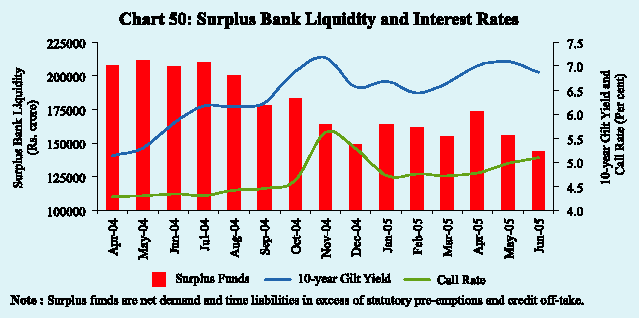
Yields softened during the first three weeks of May 2005 with the decline in international crude oil prices and easing of inflation. As crude oil prices renewed their upward climb, the 10-year yield hardened to 6.89 per cent on June 30, 2005 (Chart 51). Thus, yields increased by 24 basis points between end-March and end-June 2005. The 10-year yield stood at 7.17 per cent as on July 20, 2005.
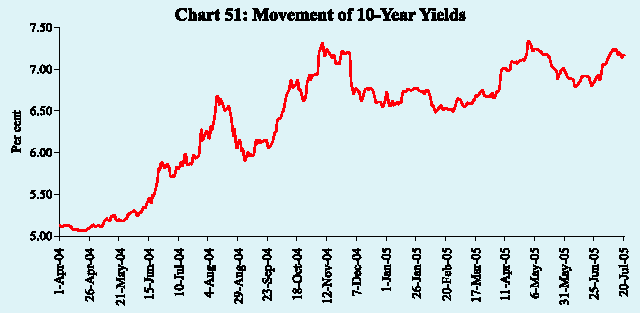
The yield curve shifted upwards with the hardening of yields across the maturity spectrum (Chart 52). The spread between 1-year and 10-year yields declined marginally to 111 basis points at end-June 2005 (from 114 basis points at end-March) while that between 10-year and 30-year yields increased marginally to 56 basis points (from 54 basis points at end-March).
In line with the Government securities market, the yields on 5-year AAA-rated corporate bonds edged up by 11 basis points at end-June 2005 over their
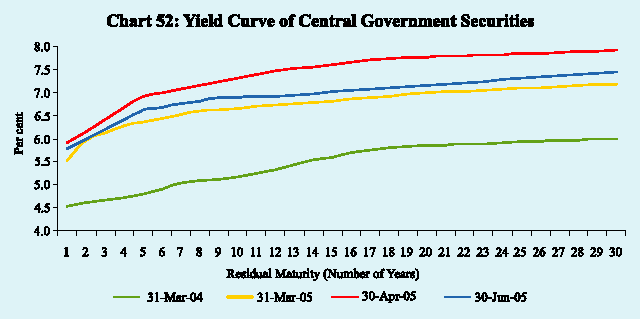
end-March level. The yield spread between 5-year Government securities and 5-year AAA-rated corporate bonds at 50 basis points was almost the same as at end-March 2005 (Chart 53).
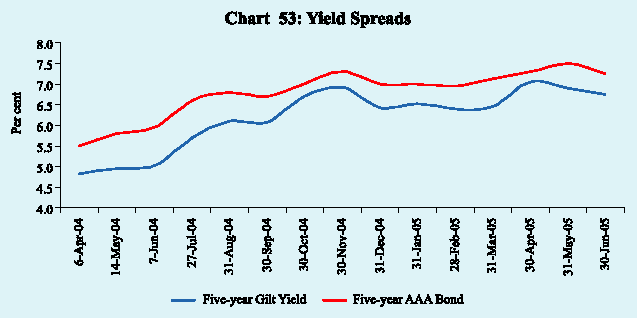
Equity Market
The capital market exhibited strong pick-up in activity and sentiment during of 2005-06. The number of issuances in the primary segment rose sharply, Q1 although the amounts raised were somewhat lower. Equity issues continued to remain the preferred choice of corporates for raising funds. The amounts mobilised from international markets by Indian corporates increased sharply. The stock markets recovered from the weakness observed in April 2005 and gained strength during May-June 2005 buoyed by encouraging financial results by several corporates as well as firm trends in international markets. The stock markets remained impervious to the net sales by FIIs, partly due to strong support from domestic institutional investors. In June and July 2005, the BSE Sensex reached new highs, closing at 7,347.10 on July 18, 2005.
Primary Market
Resource mobilisation through public issues (excluding offers for sale) during April-June, 2005 amounted to Rs.3,884 crore through 25 issues as compared with Rs.3,251 crore through five issues during April-June, 2004 (Chart 54). The average size of public issues was substantially lower at Rs.155 crore in April-June, 2005 than Rs.650 crore in the corresponding period of the previous year.
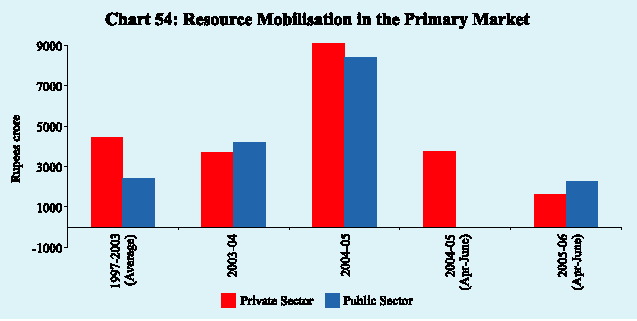
Non-Government public limited companies (private sector) accounted for 41.6 per cent of resources mobilised by way of public issues. Two public sector banks raised equity worth Rs.2,270 crore. Out of 25 issues, thirteen issues were initial public offerings (IPOs) constituting 25 per cent of total resource mobilisation. All the IPOs in the current financial year so far have been by companies in the private sector. The bulk of resources were raised by way of equity issues (Chart 55).
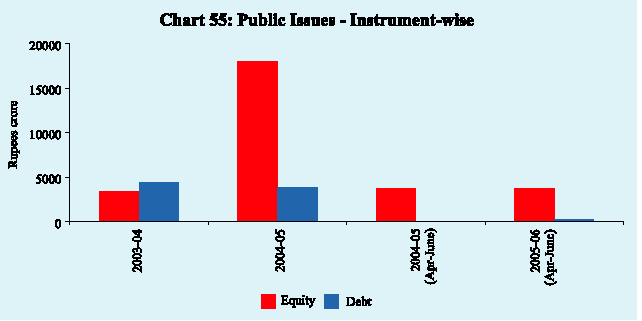
During April-June 2005, the resources raised through Euro issues by Indian corporates increased by 138.5 per cent. There were six Euro issues during April-June 2005 amounting to Rs.1,834 crore as compared with four issues of Rs.769 crore during April-June 2004.
The gross mobilisation of funds by mutual funds increased marginally during April-June 2005 by 1.7 per cent to Rs.2,08,996 crore over the corresponding period of the previous year. As most of the mutual fund schemes witnessed large redemptions under their various schemes, net funds mobilised declined by 32.5 per cent to Rs.14,273 crore during April-June 2005 over the corresponding period of the previous year (Chart 56). Scheme-wise, 73.6 per cent of the gross mobilisation of funds was under liquid/money market oriented schemes during April-June 2005. Redemption pressures were high in the case of debt-oriented schemes on expectation of a further hardening of interest rates. Net mobilisation of resources under growth/equity oriented schemes maintained their upward trend during April-June 2005, mainly due to attractive returns in a buoyant secondary market.
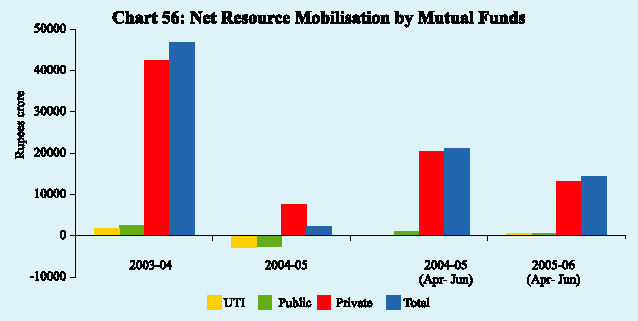
Secondary Market
The major stock indices underwent a correction from all-time high levels on post-budget enthusiasm in early March 2005 (Chart 57). The markets turned weak during April 2005 with rising international crude oil prices, a cautious approach adopted by investors ahead of the last quarter financial results of the companies and a slowdown in investments by foreign institutional investors (FIIs). Buoyancy returned in May 2005 with the declaration of strong financial results by corporates and the Government's decision to divest 10 per cent stake in Bharat Heavy Electricals Limited (BHEL). Fall in international crude oil prices,
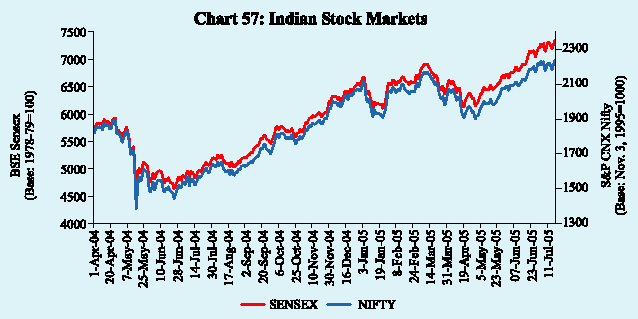
announcement of fresh reform measures in the banking sector and firm trends in major international markets also helped in improving the market sentiment.
The stock market was buoyed up further in the third week of June 2005 with the settlement of the Reliance family dispute and the onset of the monsoon. On July 18, 2005, the BSE Sensex closed at a historical high of 7347.10. The BSE Sensex registered an increase of 10.8 per cent on a point-to-point basis between end-June 2005 and end-March 2005. On an average basis, the BSE Sensex rose by 25.5 per cent during April-June 2005 over the corresponding period of the previous year, while the S&P CNX Nifty recorded an increase of 23.2 per cent (Table 30). The price-earnings (P/E) ratio at 16.0 as at end-June 2005 was marginally higher than that of 15.6 as at end-March 2005.
|
Table 30: Stock Market Indicators |
||||||||
|
Indicator |
BSE |
NSE |
||||||
|
2003-04 |
2004-05 |
April-June |
2003-04 |
2004-05 |
April-June |
|||
|
2004-05 |
2005-06 |
2004-05 |
2005-06 |
|||||
|
1 |
2 |
3 |
4 |
5 |
6 |
7 |
8 |
9 |
|
Average BSE Sensex/ |
||||||||
|
S&P CNX Nifty |
4492.19 |
5740.99 |
5263.54 |
6607.70 |
1427.5 |
1805.26 |
1659.49 |
2044.32 |
|
Volatility |
23.0 |
11.2 |
8.7 |
4.3 |
23.3 |
11.28 |
9.6 |
4.0 |
|
P/E Ratio |
||||||||
|
(End-period)* |
18.57 |
15.61 |
14.23 |
16.03 |
20.70 |
14.60 |
12.64 |
14.31 |
|
Turnover |
||||||||
|
(Rs. crore) |
5,02,618 |
5,18,716 |
1,27,291 |
1,39,647 |
10,99,535 |
11,40,071 |
2,84,769 |
2,80,917 |
|
Market Capitalisation |
||||||||
|
(Rs. crore) |
||||||||
|
(End-period) |
12,01,207 |
16,98,428 |
10,47,258 |
18,50,377 |
11,20,976 |
15,85,585 |
9,79,700 |
17,27,502 |
|
* : For 30 scrips included in the BSE Sensex and 50 scrips included in the S & P CNX NIfty. |
||||||||
The rally in the stock markets during April-June 2005 was spread across mid-cap and small-cap stocks. The BSE 500 increased by 7.1 per cent on a point-to-point basis in April-June 2005. The major sectoral indices registered gains in line with the broad trends in the stock market as well as sector-specific developments (Chart 58). The consumer durables index rose sharply (34.0 per cent) on account of robust corporate results led by increase in sales in electronics and auto segments. Fast moving consumer goods (FMCG) shares also performed well (21.8 per cent) due to progress of monsoon and solid consumer demand. The capital goods scrips were buoyant (14.2 per cent) due to strong industrial activity and positive investment climate. Public sector undertaking scrips witnessed some gains (2.5 per cent) mainly due to the decision of the Government to divest its stake in BHEL by 10 per cent. Satisfactory corporate results from software majors and the success of Infosys in raising funds through a secondary issue of ADRs contributed to the rise in IT sector scrips (7.3 per cent). The banking sector scrips registered gains of 4.3 per cent due to announcement of fresh reform measures by the Government such as providing voting rights to investors in proportion to their shareholding in private sector banks.
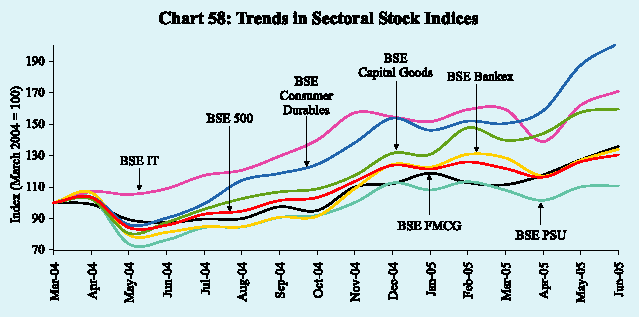
During April-May 2005, FIIs were net sellers in the equity market at Rs.1,794 crore, in sharp contrast to net purchases of Rs.4,391 crore during the corresponding period of the previous year (Chart 59). During June 2005, FIIs turned net buyers (Rs. 5,329 crore) more than offsetting the sales during April-May 2005. Domestic mutual funds made net purchases in equities of Rs.4,810 crore during April-May 2005, significantly higher than that of Rs.786 crore during the corresponding period of the previous year. During June 2005, however, mutual funds made net sales of Rs. 1,759 crore.
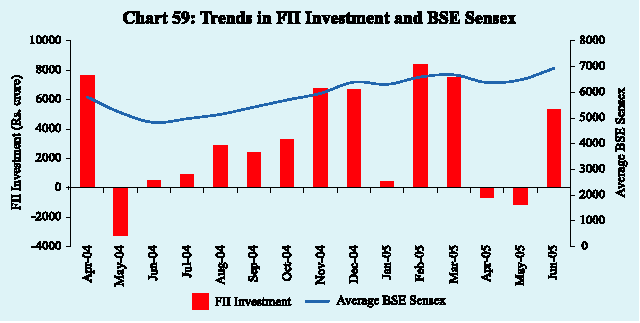
At the NSE, the total turnover in the cash segment declined marginally by 1.4 per cent to Rs.2,80,917 crore during April-June 2005 over the corresponding period of the previous year. The turnover in the NSE's derivative segment continued to be higher than in the cash segment and increased by 17.8 per cent to Rs.6,75,579 crore during April-June 2005 over a year ago (Chart 60).
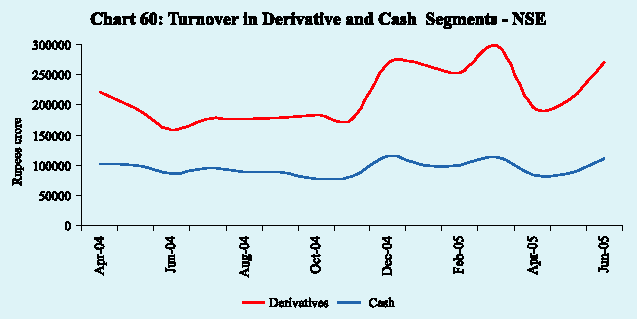
पेज अंतिम अपडेट तारीख:

















